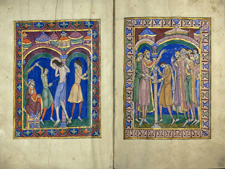Image
© Hildesheim, St Godehard |
THE FLAGELLATION
John 19:1; Luke 23:16
The scene is divided unequally under two arches. Christ, with lanky locks
of hair, and his curved back poignantly exposed to the tormentors, is
tied to the central column. The man on the right is delivering a back-hand
blow while the one on the left holds Christ’s binding cord. Pilate
sits on the side holding a whip in his right hand and making an equivocal
open-palmed gesture with his left hand. (His forefinger has been mistakenly
over painted in blue.)
The scourging is mentioned in John 19:1 and Luke 23:16 and it takes place
after Pilate’s first interview at which he wishes to release Christ
with a beating. It happens before the mocking with the crown of thorns.
Pilate’s whip and open palm indicate his words ‘I will therefore
chastise him and release him’.
Back views are rare in medieval art, but Christ’s scourging fulfils
the text of Isaiah 50:6 ‘I gave my back to the smiters, and my cheeks
to them that plucked off the hair: I hid not my face from shame and spitting’.
A close comparison is found in a Carolingian ivory in the Louvre which
includes the detail of Christ’s right foot turned to show the sole
and his straggly hair. The presence of Pilate as instigator of this scene
is quite clear from the gospel, but he is not usually shown until later
examples like Cambridge, Fitzwilliam Mus. MS. 36-1950 (AP, 58,
91, pl 110).
Quire 3.
Thread or stitch holes for protective curtain

Click
to enlarge
|
![]()